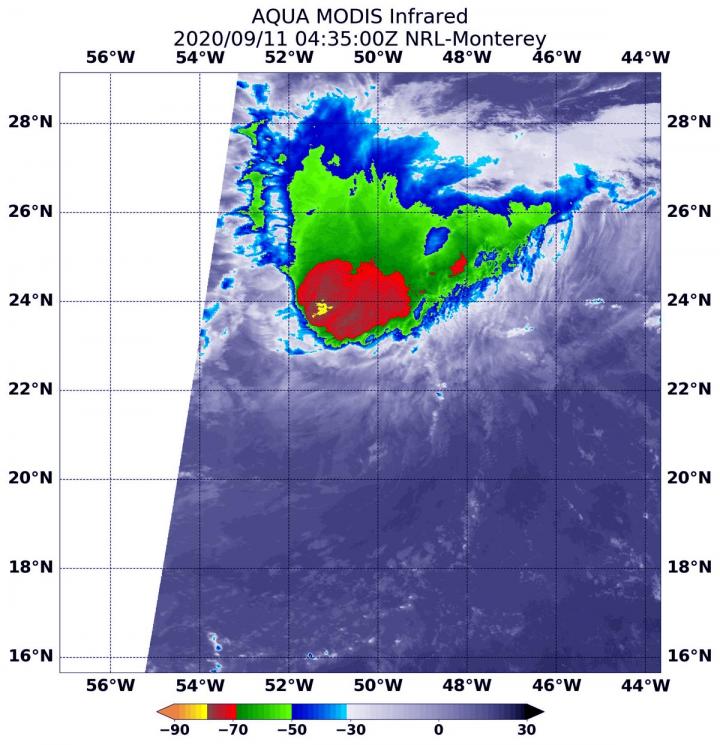
Credit: Credit: NASA/NRL
Wind shear was affecting both Tropical Storm Paulette and Rene in the Atlantic Ocean on Sept. 11. Infrared imagery from NASA’s Aqua satellite showed that strong southwesterly wind shear pushed against Paulette creating a wedge-shaped storm.
Wind Shear Affecting Paulette
Tropical cyclones that appear less than round are likely being affected by wind shear or outside winds transitioning into an extra-tropical cyclone or taking on the elongated appearance of a weather front. Today, Sept. 11, wind shear has given Paulette a wedge-shape.
The shape of a tropical cyclone provides forecasters with an idea of its organization and strength. When outside winds batter a storm, it can change the storm’s shape. Winds can push most of the associated clouds and rain to one side of a storm.
In general, wind shear is a measure of how the speed and direction of winds change with altitude. Tropical cyclones are like rotating cylinders of winds. Each level needs to be stacked on top each other vertically in order for the storm to maintain strength or intensify. Wind shear occurs when winds at different levels of the atmosphere push against the rotating cylinder of winds, weakening the rotation by pushing it apart at different levels.
At 5 a.m. EDT (0900 UTC) on Sept. 11, “Paulette continues to experience the effects of 35 to 40 knots of southwesterly vertical shear, which has caused the center to occasionally become exposed to the south and southwest of the primary convective bursts,” noted Jack Beven, Senior Hurricane Specialist at NOAA’s National Hurricane Center in Miami, Fla.
Infrared Data Reveals Effects of Wind Shear
NASA’s Aqua satellite uses infrared light to analyze the strength of storms by providing temperature information about the system’s clouds. The strongest thunderstorms that reach high into the atmosphere have the coldest cloud top temperatures.
On Sept. 11 at 12:35 a.m. EDT (0435 UTC), the Moderate Resolution Imaging Spectroradiometer or MODIS instrument that flies aboard NASA’s Aqua satellite revealed a very small area of Paulette’s most powerful thunderstorms around its center where cloud top temperatures were as cold as minus 80 degrees Fahrenheit (minus 62.2 Celsius). A larger area of strong storms with cloud top temperatures as cold as minus 70 degrees Fahrenheit (minus 56.6. degrees Celsius) surrounded the center. NASA research has found that storms with cloud tops as cold as at least minus 70 degrees Fahrenheit can generate heavy rain.
At 5 a.m. EDT on Sept. 11, NHC noted that the wind shear Paulette is currently experiencing should subside. However, it may be another 24 hours before it subsides enough so that significant strengthening can occur.
Paulette’s Status on Sept. 11
At 5 a.m. EDT (0900 UTC), the center of Tropical Storm Paulette was located near latitude 23.1 degrees north and longitude 51.7 degrees west. That is about 810 miles (1,305 km) east-northeast of the Northern Leeward Islands. Paulette is moving toward the west-northwest near 10 mph (17 kph). Maximum sustained winds are near 65 mph (100 kph) with higher gusts. Little change in strength is expected today. The estimated minimum central pressure is 991 millibars.
Paulette’s Weekend Forecast
NHC forecasters expect a motion toward the northwest for the next few days. On the forecast track, the center of Paulette should approach Bermuda Sunday night and Monday. Gradual strengthening is expected to begin tonight or on Saturday, and Paulette is forecast to become a hurricane this weekend.
Ocean Swells Expected from Paulette
Swells generated by Paulette are expected to reach portions of the Leeward Islands today and will continue to spread westward to portions of the Greater Antilles, Bahamas, Bermuda, and the southeastern United States into the weekend. These swells are likely to cause life-threatening surf and rip current conditions.
NASA Researches Earth from Space
For more than five decades, NASA has used the vantage point of space to understand and explore our home planet, improve lives and safeguard our future. NASA brings together technology, science, and unique global Earth observations to provide societal benefits and strengthen our nation. Advancing knowledge of our home planet contributes directly to America’s leadership in space and scientific exploration.
For updated forecasts, visit: http://www.
###
Media Contact
Rob Gutro
[email protected]
Original Source
https:/




